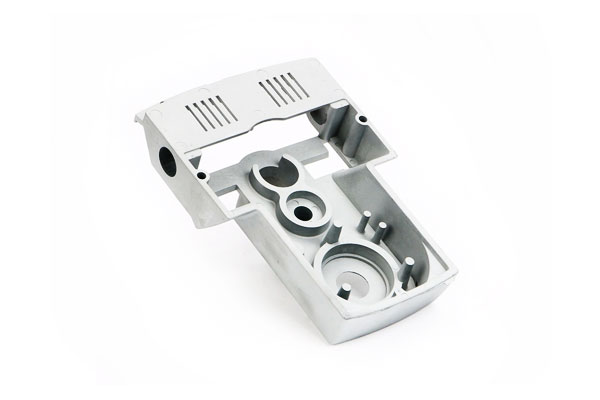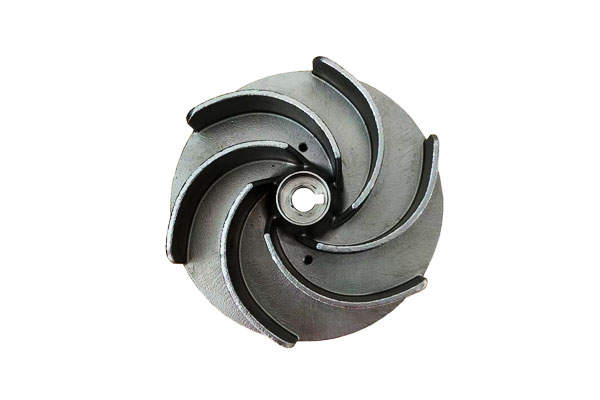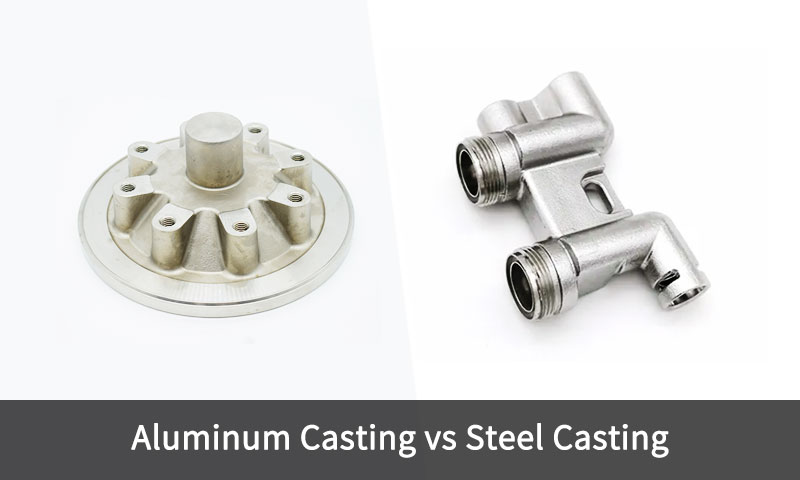1. Bevezetés
Aluminum vs Steel Casting — choosing between these two foundational materials shapes component performance, cost and manufacturability across industries from automotive to energy.
This comparison is not merely about metal chemistry: it encompasses density and stiffness, termikus viselkedés, casting process compatibility, secondary processing (hőkezelés, felületi tervezés), lifecycle cost and application-specific reliability.
Engineers and purchasers must therefore evaluate the entire system—loading, hőmérséklet, environment, production volume and finish requirements—before specifying a metal and casting route.
2. Fundamental Material Differences Between Aluminum vs Steel
At the core of aluminum vs. steel casting lies a fundamental metallurgical and physical contrast that directly affects how each material behaves during casting, megmunkálás, és kiszolgálás.
| Ingatlan | Alumínium (PÉLDÁUL., Al-i alábiak) | Acél (PÉLDÁUL., carbon or low-alloy steels) | Mérnöki következmények |
| Sűrűség (G/cm³) | 2.70 | 7.85 | Aluminum is ~65% lighter, offering major weight savings for transportation and aerospace. |
| Olvadáspont (° C) | 615–660 | 1425–1540 | Aluminum’s low melting point enables easier casting and lower energy consumption; steel requires specialized furnaces. |
| Hővezető képesség (W/m · k) | 120–180 | 40–60 | Aluminum dissipates heat efficiently—ideal for engines, hőcserélők, és elektronika. |
| Fajlagos erő (MPa/ρ) | ~100–150 | ~70–90 | Despite lower absolute strength, aluminum’s strength-to-weight ratio surpasses that of steel. |
| Rugalmassági modulus (GPA) | 70 | 200 | Steel is stiffer, providing better rigidity under load and vibration. |
Korrózióállóság |
Kiváló (forms Al₂O₃ layer) | Változó; prone to rust without coatings | Aluminum resists oxidation naturally, while steel needs surface protection (festés, galvanizálás, or alloying with Cr/Ni). |
| Megmunkálhatóság | Kiváló | Moderate to difficult | Aluminum’s softness allows easy machining and shorter cycle times; steel requires tougher tooling. |
| Újrahasznosítás | >90% recoverable | >90% recoverable | Both materials are highly recyclable, though aluminum’s remelting requires less energy (5% of primary production). |
| Casting Shrinkage (%) | 1.3–1.6 | 2.0–2.6 | Steel shrinks more during solidification, demanding larger allowances and more complex gating/feeding systems. |
| Költség (kb., USD/kg) | 2.0–3.0 | 0.8–1.5 | Aluminum is more expensive per kilogram, but savings in weight and processing can offset total lifecycle costs. |
3. What Is Aluminum Casting?
Alumínium öntvény is the process of shaping molten aluminum or aluminum alloys into complex, near-net-shape components using molds.
It is one of the most widely used metal casting processes globally—accounting for over 50% of all nonferrous castings—due to aluminum’s excellent castability, alacsony sűrűség, és korrózióállóság.

Áttekintés
In aluminum casting, olvadt alumínium (általában között 680–750°C) is poured or injected into a mold cavity where it solidifies into the desired geometry.
Aluminum’s low melting point and high fluidity make it ideal for both mass-production methods (like die casting) és nagy pontosságú alkalmazások (like investment casting).
Key Features of Aluminum Casting
- Könnyű és nagy szilárdság-súly arány:
Aluminum castings offer excellent mechanical performance while being about egyharmada az acél súlya. - Jó korrózióállóság:
Vékony, öngyógyító alumínium -oxidréteg (Al₂o₃) protects against oxidation and most atmospheric or marine corrosion. - Kiváló termikus és elektromos vezetőképesség:
Suitable for applications like hőcserélők, házak, and electric components. - Újrahasznosítás:
Aluminum can be recycled indefinitely without degradation, reducing production energy by up to 95% compared to primary smelting.
Common Aluminum Casting Processes
| Öntési módszer | Leírás | Tipikus alkalmazások |
| Die Casting | High-pressure injection of molten aluminum into steel dies; yields precise, vékonyfalú alkatrészek. | Autóalkatrészek (fogaskerékházak, zárójel), fogyasztói elektronika. |
| Homoköntés | Molten metal poured into sand molds; suitable for larger, lower-volume parts. | Motorblokkok, sokrétű, repülőgépházak. |
| Befektetési öntés | Ceramic molds from wax patterns; ideal for fine details and tight tolerances. | Repülőgép -turbina alkatrészek, orvostechnikai eszközök. |
| Állandó penészöntés | Reusable metal molds; good surface finish and dimensional control. | Dugattyú, kerekek, és a tengeri alkatrészek. |
| Centrifugális casting | Uses centrifugal force to distribute molten metal; sűrű, hibamentes felépítés. | Csövek, ujjú, and rings. |
Az alumíniumöntés előnyei
- Könnyűsúlyú: Reduces component weight by 30–50% VS. acél, improving fuel efficiency (autóipari) or payload capacity (űrrepülés).
- Energiahatékonyság: Melting aluminum requires 60–70% less energy than steel (570° C vs. 1420° C), lowering processing costs by 20–30%.
- Korrózióállóság: Eliminates the need for coatings (PÉLDÁUL., festék, galvanizáló) A legtöbb környezetben, reducing maintenance costs by 40–50%.
- High-Volume Viability: Die casting enables production of 1000+ parts/day per machine, meeting consumer goods demand.
Disadvantages of Aluminum Casting
- Alacsonyabb szilárdság: Szakítószilárdság (150–400 MPa) is 50–70% lower than high-strength steel, limiting use in heavy-load applications.
- Poor High-Temperature Performance: Retains only 50% of room-temperature strength at 250°C, making it unsuitable for engine exhaust or power plant components.
- Porozitási kockázat: Die-cast aluminum is prone to gas porosity (from high-pressure injection), restricting heat treatment options (PÉLDÁUL., T6 temper requires vacuum processing).
- Higher Raw Material Cost: Primary aluminum costs $2,500–$3,500/tonne, 2–3x more than carbon steel.
Industrial Applications of Aluminum Casting
Aluminum casting is widely used across multiple industries due to its combination of könnyű kialakítás, megmunkálhatóság, és korrózióállóság:
- Autóipar: Motorblokkok, sebességváltó házak, kerekek, and suspension arms.
- Repülőgép: Zárójel, szerkezeti szerelvények, kompresszor házak.
- Elektronika: Hőcsökkentés, motorházak, házak.
- Fogyasztási cikkek: Készülékek, elektromos szerszámok, bútor hardver.
- Marine and Renewable Energy: Hajtókészülékek, házak, és a turbina pengék.
4. What Is Steel Casting?
Steel casting is the process of pouring molten steel into a mold to produce complex, high-strength components that cannot be easily fabricated or forged.
Unlike aluminum, steel has a magasabb olvadáspont (≈ 1450–1530°C) and greater tensile strength, ideálissá teszi load-bearing and high-temperature applications such as machinery, infrastructure, és az energiatermelés.

Áttekintés
In steel casting, carefully alloyed molten steel is poured into either expendable (homok, beruházás) or permanent molds, where it solidifies into a shape close to the final part.
Because steel shrinks significantly upon cooling, precise temperature control, kapu tervezés, and solidification modeling kritikusak.
Steel castings are known for their mechanikai robusztusság, ütköző ellenállás, és a szerkezeti integritás, particularly under harsh service conditions.
Key Features of Steel Casting
- Exceptional Strength and Toughness:
Yield strengths often exceed 350 MPA, with heat-treated alloys reaching over 1000 MPA. - High-Temperature Capability:
Retains strength and oxidation resistance up to 600–800°C, depending on composition. - Versatile Alloy Selection:
Includes szénanala, alacsony ötvözött acélok, rozsdamentes acélok, and high-manganese steels, each tailored for specific environments. - Hegeszthetőség és megmunkálhatóság:
Cast steels can be post-processed effectively—machined, hegesztett, and heat-treated to enhance performance.
Common Steel Casting Processes
| Öntési módszer | Leírás | Tipikus alkalmazások |
| Homoköntés | Molten steel poured into bonded sand molds; Ideális a nagyok számára, összetett alkatrészek. | Szeleptestek, szivattyú burkolatok, machinery housings. |
| Befektetési öntés | Ceramic molds formed from wax patterns; yields excellent accuracy and surface finish. | Turbina pengék, műtéti eszközök, űrrepülési alkatrészek. |
| Centrifugális casting | Rotational force distributes molten steel evenly; produces dense cylindrical components. | Csövek, bélés, futóverseny. |
| Héjas penészöntés | Uses thin resin-coated sand molds; allows higher precision and smoother surfaces. | Kis motor alkatrészek, zárójel. |
| Folyamatos öntés | For semi-finished steel products like slabs and billets. | Raw material for rolling and forging. |
Advantages of Steel Casting
- Superior Strength & Szívósság: Szakítószilárdság (ig 1500 MPA) és az ütközési szilárdság (40–100 J) make it irreplaceable for structural safety (PÉLDÁUL., híd alkatrészek, autóipari alváz).
- Magas hőmérsékleti teljesítmény: Operates reliably at 400–600 ° C (VS. aluminum’s 250°C limit), suitable for jet engine casings and power plant boilers.
- Low Raw Material Cost: Carbon steel costs $800–$1200/tonne, 60–70% less than primary aluminum.
- Kopásállóság: Heat-treated steel (PÉLDÁUL., 4140) has surface hardness up to 500 HB, reducing replacement frequency in abrasive applications by 50–70%.
Disadvantages of Steel Casting
- High Weight: Density 2.7x that of aluminum increases fuel consumption (autóipari) or structural load (buildings).
- High Energy Use: Melting steel requires 25–30 MWh/tonne (VS. 5–7 MWh/tonne for aluminum), increasing processing costs by 40–50%.
- Korrózió -érzékenység: Carbon steel rusts in moist environments (korróziós sebesség: 0.5–1,0 mm/év in salt spray), requiring coatings (PÉLDÁUL., galvanizáló) that add $1.5–$2.5/kg to costs.
- Poor Machinability: Hardness requires specialized tools, A megmunkálási idő növelése 30–50% VS. alumínium.
Industrial Applications of Steel Casting
Steel castings dominate industries demanding erő, tartósság, és a hőállóság:
- Építés & Bányászati: Excavator teeth, zúzó alkatrészek, track links.
- Energia & Energiatermelés: Steam turbine casings, szeleptestek, nukleáris alkatrészek.
- Olaj & Gáz: Drill heads, pipeline valves, sokrétű.
- Szállítás: Train couplers, fogaskerékházak, heavy-duty engine blocks.
- Repülőgép & Védelem: Futómű, szerkezeti szerelvények, armor components.
5. Átfogó összehasonlítás: Alumínium vs acélöntvény
Process fit and part geometry
- Hüvelykujjhes, összetett, nagy volumenű alkatrészek: aluminum die casting is optimal (HPDC).
- Nagy, nehéz, load-bearing parts: steel/spheroidal graphite (Hercegek) iron and cast steels via sand casting are preferred.
- Medium volume with high integrity requirements: low-pressure aluminum or investment casting steels depending on strength needs.
Mechanical performance & utófeldolgozás
- Hőkezelés: cast steel can be quenched & tempered to obtain high strength and toughness; aluminum alloys have age-hardening routes but reach lower maximum strengths.
- Surface engineering: aluminum readily anodizes; steel can be nitrided, carburized, induction hardened or coated with hard substances (kerámia, kemény króm).
Költségvezetők (typical considerations)
- Material cost per kg: aluminum raw metal tends to be priced higher per kg than ferrous scrap/steel, but part mass reduces required amount.
- Szerszámkészítés: die casting dies are expensive (high initial amortization) but low per-part cost at volumes >10k–100k; sand tooling is cheap but per-part labor higher.
- Megmunkálás: aluminum machines faster (higher removal rates), lower tool wear; steel requires harder tooling and more machining time—raises total cost especially for small batches.
Gyártás & defect modes
- Porozitás: HPDC aluminum can develop gas and shrinkage porosity; permanent-mold and low-pressure reduce porosity.
Steel castings can suffer inclusions and segregation; controlled melting and post-HT reduce defects. - Dimenziós vezérlés: die cast aluminum attains tight tolerances (± 0,1–0,3 mm); sand cast steel tolerances are looser (±0.5–2 mm) without post-machining.
Környezeti & life-cycle
- Újrafeldolgozás: both metals are highly recyclable. Recycled aluminum uses a small fraction (~5–10%) of the energy of primary smelting; recycled steel also has large energy savings compared to virgin iron.
- Use-phase: lightweight aluminum can reduce fuel consumption in vehicles — a system-level environmental benefit.
Táblázat: Aluminum vs Steel Casting — Key Technical Comparison
| Kategória | Alumíniumöntvény | Acélöntés |
| Sűrűség (G/cm³) | ~2.70 | ~7.80 |
| Olvadáspont (° C / ° F) | 660° C / 1220° F | 1450–1530 ° C / 2640–2790°F |
| Erő (Szakító / Hozam, MPA) | 130–350 / 70–250 (esett); ig 500 hőkezelés után | 400–1200 / 250–1000 (a fokozattól és a hőkezeléstől függően) |
| Keménység (HB) | 30–120 | 120–400 |
| Rugalmassági modulus (GPA) | 70 | 200 |
| Hővezető képesség (W/m · k) | 150–230 | 25–60 |
| Elektromos vezetőképesség (% IACS) | 35–60 | 3–10 |
| Korrózióállóság | Kiváló (természetes oxidréteg) | Variable — requires alloying (CR, -Ben, MO) vagy bevonat |
| Oxidációs ellenállás (High-Temp) | Korlátozott (<250° C) | Jó és kiváló (up to 800°C for some alloys) |
| Megmunkálhatóság | Kiváló (puha, easy to cut) | Mérsékeltől szegények (nehezebb, csiszoló) |
| Önthetőség (Folyékonyság & Zsugorodás) | Magas folyékonyság, alacsony zsugorodás | Lower fluidity, higher shrinkage — needs precise gating |
| Súlyhordó előnye | ~65% lighter than steel | Heavy — suitable for structural loads |
Felületi kidolgozás |
Sima, good detail reproduction | Rougher surfaces; may need machining or shot blasting |
| Heat Treatment Flexibility | Kiváló (T6, T7 tempers) | Széles (lágyítás, eloltás, edzés, normalizálás) |
| Újrahasznosítás | >90% recycled efficiently | >90% recyclable but requires higher remelting energy |
| Production Cost | Lower energy, gyorsabb ciklusidő | Higher melting cost and tool wear |
| Tipikus toleranciák (mm) | ±0.25 to ±0.5 (fröccsöntés); ±1.0 (homoköntés) | ±0.5–1.5 depending on process |
| Environmental Footprint | Alacsony (especially recycled aluminum) | Higher CO₂ and energy footprint due to high melting point |
| Tipikus alkalmazások | Autókerekek, házak, űrrepülési alkatrészek, fogyasztási cikkek | Szelepek, turbinák, nehéz gépek, szerkezeti alkatrészek |
6. Következtetés
Aluminum and steel castings solve different engineering problems.
Aluminum excels where könnyűsúly, hővezető képesség, surface quality and high production rates matter.
Acél (and cast irons) dominate where nagy szilárdság, merevség, kopásállóság, toughness and elevated temperature performance szükségesek.
Good material selection balances functional requirements, költség (total life cycle), producibility and finishing.
In many modern designs hybrid solutions appear (steel inserts in aluminum castings, clad or bimetallic components) to exploit the strengths of both metals.
GYIK
Ami erősebb: cast aluminum or cast steel?
Cast steel is significantly stronger—A216 WCB steel has a tensile strength of 485 MPA, 67% higher than A356-T6 aluminum (290 MPA).
Steel also has far greater toughness and wear resistance.
Can cast aluminum replace cast steel?
Only in applications where weight reduction is prioritized over strength (PÉLDÁUL., automotive non-structural parts).
Steel is irreplaceable for high-load, high-temperature components (PÉLDÁUL., turbina burkolatok).
Which is more corrosion-resistant: cast aluminum or cast steel?
Cast aluminum is more corrosion-resistant in most environments (korróziós sebesség <0.1 mm/év) VS. szénacél (0.5–1,0 mm/év).
Stainless steel castings match aluminum’s corrosion resistance but cost 2–3x more.
Which casting process is best for aluminum vs. acél?
Aluminum is ideal for die casting (nagy volumenű) and sand casting (olcsó).
Steel is best for sand casting (nagy alkatrészek) és befektetési casting (összetett, high-tolerance components). Die casting is rarely used for steel.


